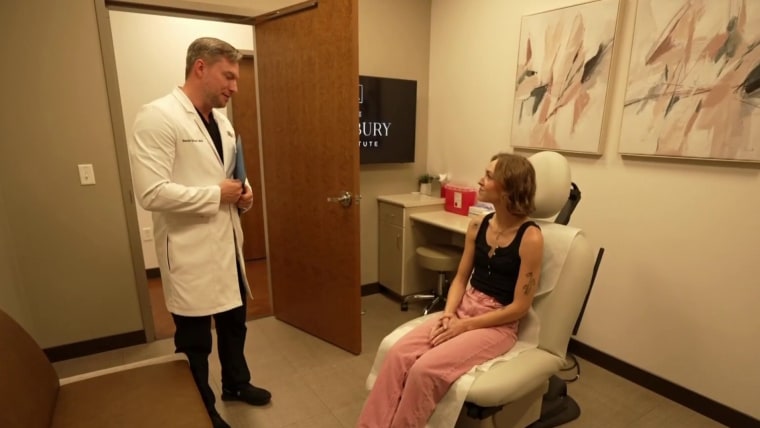This influencer’s videos show an active lifestyle. Offline, she’s fighting for treatment for a painful condition.
Aurora McCausland has lipedema, a painful disorder that causes a buildup of fat in the lower body. Her doctor said surgery could fix it, but her insurance has denied coverage.
A scroll through Aurora McCausland’s wildly popular social media accounts — she has more than 300,000 followers across TikTok and Instagram — shows an active young mom dancing, cleaning and tackling major renovation projects in her Utah home.
Behind the scenes, though, is a painful reality: McCausland has lipedema, a progressive and debilitating disease that causes fat in connective tissue to build up disproportionately, most often in the legs, ankles and hips.
She said her legs throb with pain, swell unpredictably and feel heavy, like they’re filled with cement. It’s a major source of frustration for the mother of two young children. Standing up can cause her to black out.
“Things that I feel like I should be able to do cause pain pretty quickly, and then I kind of have to tap out,” said McCausland, 30, of West Valley City, Utah. “Getting down to play with my kids is really hard.”

She’s tried to manage the pain with compression garments, lymphatic drainage and anti-inflammatory diets.
“Those are helpful at potentially slowing down the disease,” her physician, Dr. David Smart, said. “But really, only surgery helps to reverse the disease process.”
Smart is a dermatologic surgeon at the Roxbury Institute in Murray, Utah. He performs a specialized type of liposuction that removes the diseased tissue to restore mobility.
The procedure isn’t cosmetic, and despite the buildup of fat, lipedema isn’t related to obesity. It’s not caused by overeating or inactivity. It’s a hormonally driven inflammatory condition, one that’s largely resistant to diet and exercise.
“It goes against the more traditional health dogma that’s out there about normal fat,” Smart said.
Lipedema is almost exclusively seen in women, but scientists don’t have a good handle on how many are affected. Some estimates suggest it may affect up to 11% of women.
“There are no large-scale, population-based epidemiologic estimates. We don’t have blood tests. We don’t have imaging studies,” said Dr. Aaron Aday, co-director of vascular medicine at Vanderbilt University Medical Center in Nashville, Tennessee.
Denied relief
Many women first notice symptoms of lipedema at puberty, and the disease often worsens during major hormonal shifts like pregnancy or menopause.
McCausland said her symptoms first appeared during her early teens: leg pain, swelling and bruising from the slightest touch. “I thought it was just growing pains,” she said. Fat built up around her ankles. No matter how physically active she was — dancing and CrossFit were two hobbies — she couldn’t make the fat in her lower legs go away.
Still, she was told it was just excess weight. “That if I worked out more, ate less, it would go away,” she said. “But no matter what I did, my legs just hurt more. I was doing everything right and getting worse.”
If you are dealing with bills that seem to be out of line or a denial of coverage, care or repairs, whether for health, home or auto, please email us at [email protected].
McCausland’s five sisters experienced similar symptoms. She said none knew what the problem was until one of the sisters got liposuction to slim down her lower legs.
But lipedema fat isn’t the same as typical fat. Instead of feeling soft, it can feel like hard nodules under the skin. Regular liposuction can be risky to use on lipedema patients.
It took far longer than it should have for her sister’s doctor to do the procedure, McCausland said.
“The doctor ended up giving her third-degree internal burns all on her legs, because he didn’t know that it wasn’t normal fat. He just kept going, having to go over and over and over trying to remove it,” she said. “It was just this horrible thing that happened. Obviously the doctor had no idea that she had this condition, and neither did my sister.”
Aday — who hasn’t treated McCausland — said that a specialized type of liposuction, performed by a surgeon with extensive knowledge of lipedema, is the most effective way to treat the disorder. It can reverse symptoms in many people. Some patients, he said, may have to have the procedure repeated.
The Roxbury Institute said that McCausland would need two liposuction surgeries, totaling more than $35,000. But her former insurance provider, Cigna Healthcare, denied coverage for the procedure twice.
In an emailed statement, a Cigna representative said: “Lipedema is a painful condition that disproportionately impacts women, and we cover a range of treatment options, including liposuction, for patients that meet evidence-based clinical criteria. Ms. McCausland’s case was carefully reviewed by multiple doctors, including a plastic surgeon with expertise in lipedema. Based on the information submitted by her doctor, she did not meet the clinical criteria for liposuction at that time.”
McCausland believes her coverage was denied because she didn’t look sick enough, adding that she suspects the denial was based on her social media posts.
They said “that it’s not medically necessary,” McCausland said. “That’s absurd. They’re not looking at how I live. They’re looking at a photo and deciding I don’t look bad enough to be helped.”
Cigna told NBC News that social media isn’t considered when it makes coverage decisions. “Our coverage decisions are based on the clinical information submitted by a patient’s treating physician in accordance with coverage policies and the patient’s plan design,” the representative said.
McCausland’s health insurance has since switched to MotivHealth, because of her husband’s new job. McCausland said MotivHealth has already suggested to her in a phone call that it’s not a procedure it usually covers but that she can submit additional documentation. A representative for the company didn’t respond to several requests for comment.
A long under-recognized disease
Lipedema is categorized in four stages, based on visual appearance. Stage 1 looks like minor fat accumulation and Stage 4 appears as severe leg disfigurement. Appearance, however, doesn’t always match the severity of symptoms.
“You can have a Stage 1 patient that has very severe and crippling symptoms of pain and swelling, and somebody who is maybe more progressed visibly that doesn’t have such severe symptoms,” Smart said.
McCausland is a prime example. She doesn’t look sick, according to some commenters on her social media videos.

“I’ve gotten a handful of people saying, ‘Well, I’ve looked at your other videos, and I agree with your insurance company,’” she said.
“This is very likely the reason why lipedema has been so under-recognized for such a long time,” Smart said. “So many people, so many insurance companies, so many physicians, have been telling lipedema patients for decades to just ‘work out, eat better, lose weight,’ when that’s not actually the problem.”
He said waiting until the condition progresses is dangerous. Without treatment, lipedema advances, causing more inflammation, worsening pain and permanent joint damage. The longer surgery is delayed, the harder it is to restore mobility in later stages.
“It’s really unfortunate for Aurora, because at that early stage, it is less likely that she gets insurance coverage,” Smart said. “They’re not looking at the severity of her symptoms. They’re not looking at the severity of her pain, the decrease in mobility, her lack of ability to be able to perform those daily activities of living.”
Jonathan Kartt, chief executive officer of the Lipedema Foundation, said that the pain experienced by women with lipedema can be measured objectively.
Using a tool to measure how patients perceive stimuli like temperature and touch, researchers in Germany found that women with lipedema had a lower pain threshold compared with other women. The pain was specific to areas affected by the disease.
“The differences were so stark,” Kartt said, that it’s possible to use “this test to actually diagnose or confirm a diagnosis of lipedema.”
Aday, of Vanderbilt, is leading an effort to create a national biobank of information on lipedema patients. The team takes blood samples and urine, as well as fat and skin biopsies.
“It’s meant to be a living research resource,” he said. “We want other investigators to use these data, build upon it and generate new data.”
There is also growing excitement in the lipedema field to see whether the blockbuster GLP-1 drugs, like Ozempic and Wegovy, might be useful. The drugs are mainly used to treat Type 2 diabetes and obesity, but have been shown to provide benefits for other diseases. Aday is working to secure funding for such a study.


